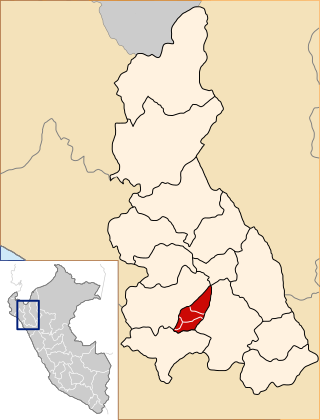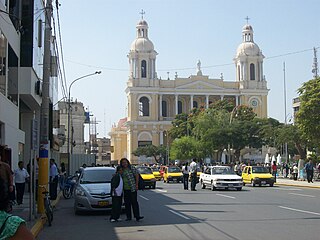
Cajamarca is a department and region in Peru. The capital is the city of Cajamarca. It is located in the north part of the country and shares a border with Ecuador. The city has an elevation of 2,700 metres (8,900 ft) above sea level in the Andes Mountain Range, the longest mountain range in the world. Part of its territory includes the Amazon Rainforest, the largest in the world.

La Libertad is a department and region in northwestern Peru. Formerly it was known as the Department of La Libertad. It is bordered by the Lambayeque, Cajamarca and Amazonas regions on the north, the San Martín Region on the east, the Ancash and Huánuco regions on the south and the Pacific Ocean on the west. Its capital is Trujillo, which is the nation's third biggest city. The region's main port is Salaverry, one of Peru's largest ports. The name of the region is Spanish for "freedom" or "liberty"; it was named in honor of the Intendancy of Trujillo's proclaiming independence from Spain in 1820 and fighting for that. It is the ninth smallest department in Peru, but it is also its second-most populous department after Piura and its second-most densely populated department after Lambayeque.
San Ignacio is a common toponym in parts of the world where that language is or was spoken:

Santa Cruz Province is a province in the Cajamarca Region of Peru, with its capital at Santa Cruz de Succhabamba. The province has an area of 1,417.93 km2 and the government population estimate for 2002 is 49,302, with the 1993 census showing a population of 44,571. Agriculture is the predominant economic activity.

The Rioja Province is one of ten provinces of the San Martín Region in northern Peru.

Huancabamba Province is a landlocked province in the Piura Region in northwestern Peru. The province is the easternmost in the region.

The Chiclayo Province is one of three provinces of the Lambayeque Region in Peru.

The Ferreñafe Province is the smallest of three provinces of the Lambayeque Region in Peru.
The Chinchipe River is a river on the border between Ecuador and Peru. It rises in Ecuador, in the Zamora-Chinchipe Province, in the Podocarpus National Park. Then it flows through the Piura Region, and the Cajamarca Region in the San Ignacio Province of Peru. The river flows into the Maranon River.

Chepén Province is one of the twelve provinces that make up the La Libertad Region of Peru. It is bordered on the north by the Lambayeque Region, on the east by the Cajamarca Region, on the south by Pacasmayo Province, and on the west by the Pacific Ocean. The capital of the Chepén province is the city of Chepén.

The Cutervo Province is one of the thirteen that make up the Cajamarca Region of Peru. It is the home of the Cutervo National Park. It has a population of 162,686 and an area 3,028.46 square kilometers (1,169.29 sq mi).

San Pablo Province is a province of the Cajamarca Region in Peru. The capital of the province is the city of San Pablo.

The Jaén Province is one of the thirteen provinces in the Cajamarca Region of Peru. Geographically, the province has a mountainous terrain crisscrossed by the rivers of the Huancabamba-Chamaya Basin, which drain towards the Marañón River. Its weather is characterized by high temperatures all year long and heavy rains from October through March. Agriculture and husbandry absorb over half of the province workforce; rice and coffee are main crops.

The San Miguel Province is one of the thirteen provinces in the Cajamarca Region of Peru. It was created by Law No. 15152 on September 29, 1964 by president Fernando Belaunde Terry. It has a mountainous territory which varies in height from 500 to more than 4,000 metres (1,600–13,000 ft) above sea level. As a result, there is a great diversity of climates ranging from hot and dry at lower altitudes to cold and rainy at higher levels. Herding is an important economic activity thanks to the existence of extensive pastures. Its main product is cow's milk which is either sold outside the province or transformed into dairy products such as cheese. There are several gold mines in production in the higher regions of the province. There's also an important handicraft industry mainly devoted to textiles made out of cotton or wool.

The Roman Catholic Diocese of Chiclayo is a Latin Catholic suffragan diocese in the ecclesiastical province of Piura in Peru's northwestern Lambayeque region.
Chota District is one of nineteen districts in the Chota Province in Peru. It is located in the central part of the province in the northern Andean region of Peru. Its capital is located on the plateau of Acunto at 2,388 meters above sea level and 150 km north of Cajamarca, or 219 km east of Chiclayo, Lambayeque.
Pimpingos District is one of fifteen districts of the Cutervo Province in the Cajamarca Region in Peru. It was created on 22 October 1910 by Law No. 1296. It is one of the oldest districts of the province.

San Ignacio District is one of seven districts of the province San Ignacio in Peru.
Collor is an archaeological site in Peru. It is situated in the Cajamarca Region, Cajamarca Province, Namora District. The site lies at a height of about 2,970 metres (9,744 ft) on a mountain named Coyor, east of Lake San Nicolas.

The city of San Ignacio is one of the thirteen provinces that make up the Department of Cajamarca, under the administration of the regional government of Cajamarca, in Peru. It bordered on the north by the province of Zamora Chinchipe (Ecuador); on the east by the Department of Amazonas; on the south by the province of Jaen; on the west by the Department of Piura. It is known as the land of coffee, honey and natural forests. Its population by economic activity agriculture which is based exclusively to coffee.
















